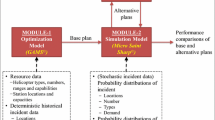Abstract
This paper describes an efficient planning system for coordinating helicopter operations in disaster relief. This system can be used as a simulation tool in contingency panning for better disaster preparedness and helps to generate plans with estimated data. The proposed system consists of a mathematical model and a Route Management Procedure (RMP) that post-processes the outputs of the model. The system is concerned with helicopter operations that involve last mile distribution and pickups for post-disaster medical care and injured evacuation. Delivering items such as medicine, vaccines, blood, i.v., etc. to affected locations, and evacuating injured persons from these locations comprise the transportation tasks to be performed by helicopters. The proposed modeling system accommodates the special aviation constraints of helicopters and it can handle large scale helicopter missions. The goal of the system is to minimize the total mission time required to complete the transportation task. The RMP enables the Decision Maker (DM) to specify either the mission completion time or the number of vehicles available for the mission. Respecting the limitations imposed by the DM, the RMP generates fuel and capacity feasible helicopter itineraries that complete within the specified mission completion time. A scenario that is based on the post-earthquake damage data provided by the Disaster Coordination Center of Istanbul is used for testing the method.
Similar content being viewed by others
References
Altay N, Green WG III (2006) OR/MS research in disaster operations management. Eur J Oper Res 175: 475–493
Apte A (2009) Humanitarian logisitics: A new field of research and action, Foundations and Trends in Technology. Inf Oper Manag 3: 1–100
Apte A, Heath S (2009) A plan for evacuation of disabled people in the face of a disaster, Working Paper, Naval Postgraduate School, Monterey
Bakuli DL, Smith JM (1996) Resource allocation in state dependent emergency evacuation networks. Eur J Oper Res 89: 543–555
Balcik B, Beamon BM, Smilowitz K (2008) Last mile distribution in humanitarian relief. J Intell Transp Syst 12: 51–63
Barbarosoglu G, Ozdamar L, Cevik A (2002) An interactive approach for hierarchical analysis of helicopter logistics in disaster relief operations. Eur J Oper Res 140: 118–133
Beamon BM, Balcik B (2008) Performance measurement in humanitarian relief chains. Int J Public Sect Manag 21: 4–25
Chiu YC, Zheng H (2007) Real time mobilization decision for multi-priority emergency response resources and evacuation groups: Model formulation and solution. Transp Res: Part E 43: 710–736
DeAngelis V, Mecoli M, Nikoi C, Storchi G (2007) Multiperiod integrated routing and scheduling of World Food Programme cargo planes in Angola. Comput Oper Res 34–36(6): 1601–1615
Haghani A, Oh SC (1996) Formulation and solution of a multi-commodity, multi-modal network model for disaster relief operations. Transp Res Part A Policy Pract 30: 231–250
Mete HO, Zabinsky ZB (2010) Stochastic optimization of medical supply location and distribution in disaster management. Int J Prod Econ 126(1): 76–84
Ozdamar L, Ekinci E, Kucukyazici B (2004) Emergency logistics planning in natural disasters. Ann Oper Res 129: 217–245
Sayyady F, Eksioglu SD (2008) Optimizing the use of public transit system during no-notice evacuations of urban areas, Working Paper, Mississippi State University, Mississippi
Sierksma G, Tijssen GA (1998) Routing helicopters for crew exchanges on off-shore locations. Ann Oper Res 76: 261–286
Solomon M, Chalifour A, Desrosiers J, Boisvert J (1992) An application of vehicle routing methodology to large-scale larvicide control programs. Interfaces 22: 88–99
Stapleton O, Pedraza Martinez A, Van Wassenhove LN (2009) Last mile vehicle supply chain in the International Federation of Red Cross and Red Crescent Societies, Faculty and Research Working Paper, INSEAD, France
Timlin MT, Pulleyblank WR (1992) Precedence constrained routing and helicopter scheduling: heuristic design. Interfaces 22: 100–111
Tomasini R, Van Wassenhove LN (2009) Humanitarian logistics. Palgrave Macmillan, Basingstoke
Van Wassenhove LN (2006) Humanitarian aid logistics: supply chain management in high gear. J Oper Res Soc 57: 475–489
Yi W, Ozdamar L (2007) A dynamic logistics coordination model for evacuation and support in disaster response activities. Eur J Oper Res 179: 1177–1193
Author information
Authors and Affiliations
Corresponding author
Rights and permissions
About this article
Cite this article
Ozdamar, L. Planning helicopter logistics in disaster relief. OR Spectrum 33, 655–672 (2011). https://doi.org/10.1007/s00291-011-0259-y
Published:
Issue Date:
DOI: https://doi.org/10.1007/s00291-011-0259-y




